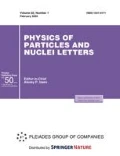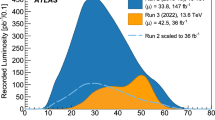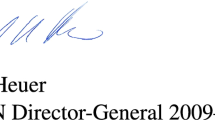Abstract
The formulae for m-order correlators K m of a given particle observable (e.g., energy, transverse momentum or a conserved discrete quantum number) accounting for the track reconstruction efficiencies in a real detector are presented. The calculation of second- to fourth-order correlators is considered in some detail. Similar to the case of an ideal detector, the correlators can be expressed through the event-by-event fluctuation measures of the observable single event mean, the pseudocorrelators (determined by the pseudo-central moments of the observable distribution) and their cross terms. It allows one to avoid the combinatorics and essentially reduce the computer time when calculating the higher-order correlators in high multiplicity events. Compared with the case of ideal detector, this reduction is somewhat smaller due to the increased number of pseudocorrelators and additional calculations of the moments of the distribution of the track weights. For a constant track reconstruction efficiency, the correlator formulae reduce to those for an ideal detector. However, in real experiments the efficiencies are usually essentially dependent on particle momenta and may lead to substantial corrections of momentum correlators on the level of tens of percent.
Similar content being viewed by others
References
W. Kittel and E. A. De Wolf, Soft Multihadron Dynamics (World Sci., USA, Hackensack, 2005), p. 652.
E. A. De Wolf, I. M. Dremin, and W. Kittel, Phys. Rep. 270, 1 (1996); hep-ph/9508325.
I. M. Dremin and J. W. Gary, Phys. Rep. 349, 301 (2001); hep-ph/0004215.
C. Athanasiou, K. Rajagopal, and M. Stephanov, Phys. Rev., Ser. D 82, 074008 (2010); arXiv:1006.4636 [hep-ph].
J. Manjavidze and A. Sissakian, Phys. Rep. 346, 1–88; arXiv:hep-ph/0105245.
A. Sissakian, “On the status of very high multiplicity physics,” in The 32nd Int. Symp. on Multiparticle Dynamics (ISMD 2002), Alushta, Ukraine, 2002, pp. 353–357; Phys. At. Nucl. 67, 2 (2004); Yad. Fiz. 67, 4 (2004).
N. Amelin et al., Phys. Part. Nucl. Lett. 4, 461 (2007); arXiv:nucl-th/0504007.
A. V. Stadnik, N. I. Chernov, and S. S. Shimanskiy, JINR Commun. P11-2003-143 (Dubna, 2003); S. S. Shimanskiy, in Proc. of the Sixth Int. Workshop “Very High Multiplicity”, Dubna, 2005, pp. 328–346.
J. Budagov et al., “On correlators for high multiplicity events,” in The 32nd Int. Symp. on Multiparticle Dynamics (ISMD 2002), Alushta, Ukraine, 2002; Phys. At. Nucl. 67, 69 (2004); Yad. Fiz. 67, 70 (2004).
P. Filip, “Corrections to correlators in fluctuation measurements,” Phys. Rev., Ser. C 78, 034912 (2008); arXiv:0711.0608 [nucl-th].
J. Adams et al. (STAR Collab.), “Incident energy dependence of correlations at RHIC,” Phys. Rev., Ser. C. 72, 044902 (2005); arXiv:nucl-ex/0504031.
Maplesoft, Maple: Computer Algebra System; http://www.maplesoft.com/; http://en.wikipedia.org/wiki/Maple (software).
T. Sjostrand et al., “PYTHIA 6.4 physics and manual,” JHEP 05, 026 (2006).
J. Von Neumann, Various Techniques Used in Connection with Random Digits, Monte Carlo Methods, National Bureau Standards (1951), Vol. 12, pp. 36–38.
G. Aad et al. (ATLAS Collab.), Expected Performance of the ATLAS Experiment—Detector, Trigger and Physics, 2009, p. 1852; SLAC-R-980, CERN-OPEN-2008-020; arXiv:0901.0512 [hep-ex].
S. Chatrchyan et al. (CMS Collab.), “The CMS experiment at the CERN LHC,” JINST 3, S08004 (2008).
K. A. Bloom et al. (CDF Collab.), Track Reconstruction for the CDF Silicon Tracking System, FERMILAB-CONF-98-370-E.
T. Allmendinger et al., Nucl. Instr. Meth., Ser. A 704, 44 (2013); arXiv:1207.2849 [hep-ex].
Z. Xu et al., LBNL-PUB-5509, 2006, p. 84.
Author information
Authors and Affiliations
Additional information
The article is published in the original.
Rights and permissions
About this article
Cite this article
Gusev, A.A., Kulchitsky, Y.A., Lednicky, R. et al. Calculating particle correlators with the account of detector efficiency. Phys. Part. Nuclei Lett. 10, 560–565 (2013). https://doi.org/10.1134/S1547477113060113
Published:
Issue Date:
DOI: https://doi.org/10.1134/S1547477113060113




